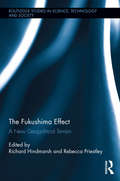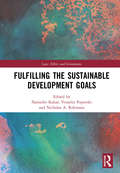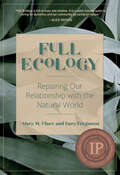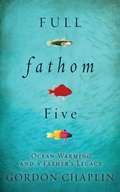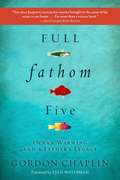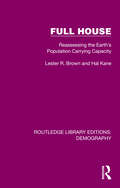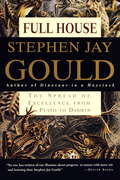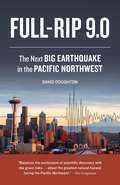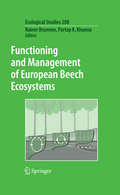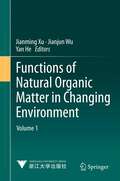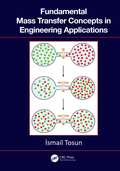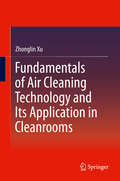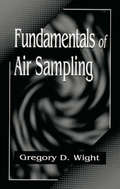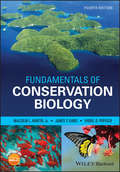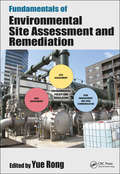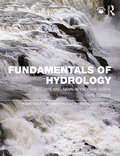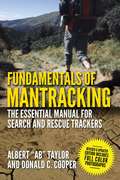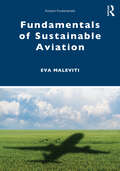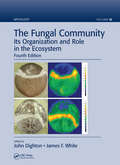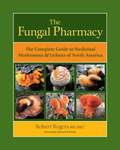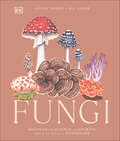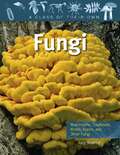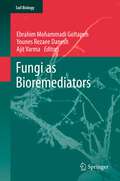- Table View
- List View
The Fukushima Effect: A New Geopolitical Terrain (Routledge Studies in Science, Technology and Society)
by Richard Hindmarsh Rebecca PriestleyThe Fukushima Effect offers a range of scholarly perspectives on the international effect of the Fukushima Daiichi nuclear meltdown four years out from the disaster. Grounded in the field of science, technology and society (STS) studies, a leading cast of international scholars from the Asia-Pacific, Europe, and the United States examine the extent and scope of the Fukushima effect. The authors each focus on one country or group of countries, and pay particular attention to national histories, debates and policy responses on nuclear power development covering such topics as safety of nuclear energy, radiation risk, nuclear waste management, development of nuclear energy, anti-nuclear protest movements, nuclear power representations, and media representations of the effect. The countries featured include well established ‘nuclear nations’, emergent nuclear nations and non-nuclear nations to offer a range of contrasting perspectives. This volume will add significantly to the ongoing international debate on the Fukushima disaster and will interest academics, policy-makers, energy pundits, public interest organizations, citizens and students engaged variously with the Fukushima disaster itself, disaster management, political science, environmental/energy policy and risk, public health, sociology, public participation, civil society activism, new media, sustainability, and technology governance.
Fulfilling the Sustainable Development Goals: On a Quest for a Sustainable World (Law, Ethics and Governance)
by Narinder Kakar, Vesselin Popovski and Nicolas A. RobinsonThis book contains assessment of the progress, or the lack of it, in implementing the UN Sustainable Development Goals (SDGs). Through review of the assessments and of case studies, readers can draw lessons from the actions that could work to positively address the goals. The 2030 Agenda for Sustainable Development is designed to catalyze action in critical areas of importance to humanity and the planet. The effort to implement the SDGs, however, demands a sense of urgency in the face of environmental degradation, climate change, emerging conflicts, and growing inequality, among a number of other socio-economic problems. Five years after the launch of the 2030 Agenda, this book takes stock of how far the world has come and how we can position ourselves to achieve the global targets. The book is one of the first to assess how the implementation is impeded by the onset of COVID-19. It contains a special chapter on COVID-19 and the SDGs, while many thematic chapters on different SDGs also assess how COVID-19 adversely affects implementation, and what measures could be taken to minimize the adverse effects. This publication thus provides a fresh look at implementation of the SDGs highlighting impactful and creative actions that go beyond the business-as-usual development efforts. The volume reinforces this analysis with expert recommendations on how to support implementation efforts and achieve the SDGs through international and national strategies and the involvement of both the public and private sectors. The result is an indispensable textual tool for policy makers, academia, intergovernmental organizations (IGOs) and non-governmental organizations (NGOs), as well as the public, as we march toward the 2030 deadline.
Full Ecology: Repairing Our Relationship with the Natural World
by Gary Ferguson Mary M. ClareHow to confront the climate crisis without losing heart It’s easy to feel overwhelmed in the face of global climate breakdown. So how might we develop the inner resolve to confront it? Full Ecology, a collaboration between social-cultural psychologist Mary M. Clare and longtime science writer Gary Ferguson, suggests a path forward. Breaking the modern impulse to see humans as separate from nature, Clare and Ferguson encourage us to learn from the &“supremely methodical and highly improvisational&” natural systems that touch our lives. True change, they argue, begins with us stopping and questioning assumptions about our place in the world. From this process of reflection, they offer us an alternative blueprint for acting in ecologically healthy ways, and for inspiring others to do the same. Rather than proposing a ten-step plan to save the earth, this book encourages a more elemental rethinking of our connections to nature, and of how such connections might be strengthened for the common good. Practical and poetic, scientific and spiritual, Full Ecology presents a strong, nourishing foundation for climate action.
Full Fathom Five
by Gordon ChaplinGordon Chaplin's father was a seemingly happy-go-lucky, charismatic adventurer who married a wealthy heiress and somehow transformed himself into the author of a landmark scientific study, Fishes of the Bahamas, published by the Academy of Natural Sciences of Philadelphia. As a young boy, the author took part in collecting specimens for his father. Fifty years later, he was asked to join a team from the same institution studying the state of sea life in the Bahamian waters where he grew up, as measured against his father's benchmark. The first of the sea changes presented in this eloquent book stems from climate change and is the drastic transformation of ocean life due to global warming. The second is his father's miraculous transformation from presumed playboy into scientist. And the third involves the author's own complicated relationship with his parents and in particular his father, as he grew older and assumed the part of the prodigal son. Fifty years later, returning to his childhood home, he delves into the mysteries of his father's life and the impossibility of ever truly recovering the past, or ever returning home.Illustrated with gorgeous color plates from the original Fishes of the Bahamas and featuring descriptions of exquisite undersea beauty and heartrending devastation, this is a status report on climate change unlike any other, both a report from the field and an intensely personal reckoning.
Full Fathom Five: Ocean Warming and a Father's Legacy
by Gordon Chaplin Stan Waterman"Not since Jacques Cousteau has anyone brought us the sense of the ocean as our home . . . Far more than a science book.” -San Francisco Book ReviewGordon Chaplin’s father was a seemingly happy-go-lucky, charismatic adventurer who married a wealthy heiress and transformed himself into the author of a landmark scientific study, Fishes of the Bahamas. The book was published by the Academy of Natural Sciences of Philadelphia, one of America's most esteemed scientific institutions. As a young boy, the author took part in collecting specimens for his father. Fifty years later, he was asked to join a team studying the state of sea life in the Bahamian waters where he grew up, as measured against his father’s benchmark.The first of the sea changes presented in this eloquent book stems from climate change and is the drastic transformation of ocean life due to global warming. The second is his father’s miraculous transformation from playboy into scientist. And the third involves the author’s own complicated relationship with his parents, in particular his father, as he grew older and assumed the part of prodigal son. Fifty years later, returning to his childhood home, he delves into the mysteries of his father’s life and the impossibility of ever truly recovering the past or returning home.
Full House: Reassessing the Earth’s Population Carrying Capacity (Routledge Library Editions: Demography #2)
by Lester R. Brown Hal KaneOriginally published in 1995, after decades of steady growth, this book was written at a time when the world’s food supply was no longer keeping up with population increases. This book examines the causes of the imbalance in the food/population equation and suggests ways in which Malthusian checks can be countered. It calls for an international strategy to restore global security, and a budget to implement it, with a massive redirection of the world’s financial resources. On one side of the argument the authors advocate increased expenditure on family planning services, education, and women’s rights. On the other, they stress the environmental importance of reforestation and soil conservation schemes to halt the deterioration of the agricultural resource base.
Full House: The Spread of Excellence from Plato to Darwin
by Stephen Jay GouldFew would question the truism that humankind is the crowning achievement of evolution; that the defining thrust of life's history yields progress over time from the primitive and simple to the more advanced and complex; that the disappearance of .400 hitting in baseball is a fact to be bemoaned; or that identifying an existing trend can be helpful in making important life decisions. Few, that is, except Stephen Jay Gould who, in his new book Full House: The Spread of Excellence from Plato to Darwin, proves that all of these intuitive truths are, in fact, wrong. "All of these mistaken beliefs arise out of the same analytical flaw in our reasoning, our Platonic tendency to reduce a broad spectrum to a single, pinpointed essence," says Gould. "This way of thinking allows us to confirm our most ingrained biases that humans are the supreme being on this planet; that all things are inherently driven to become more complex; and that almost any subject can be expressed and understood in terms of an average." In Full House, Gould shows why a more accurate way of understanding our world (and the history of life) is to look at a given subject within its own context, to see it as a part of a spectrum of variation rather than as an isolated "thing" and then to reconceptualize trends as expansion or contraction of this "full house" of variation, and not as the progress or degeneration of an average value, or single thing. When approached in such a way, the disappearance of .400 hitting becomes a cause for celebration, signaling not a decline in greatness but instead an improvement in the overall level of play in baseball; trends become subject to suspicion, and too often, only a tool of those seeking to advance a particular agenda; and the "Age of Man" (a claim rooted in hubris, not in fact) more accurately becomes the "Age of Bacteria." "The traditional mode of thinking has led us to draw many conclusions that don't make satisfying sense," says Gould. "It tells us that .400 hitting has disappeared because batters have gotten worse, but how can that be true when record performances have improved in almost any athletic activity?" In a personal eureka!, Gould realized that we were looking at the picture backward, and that a simple conceptual inversion would resolve a number of the paradoxes of the conventional view. While Full House deftly reveals the shortcomings of the popular reasoning we apply to everyday life situations, Gould also explores his beloved realm of natural history as well. Whether debunking the myth of the successful evolution of the horse (he grants that the story still deserves distinction, but as the icon of evolutionary failure); presenting evidence that the vaunted "progress of life" is really random motion away from simple beginnings, not directed impetus toward complexity; or relegating the kingdoms of Animalai and Plantae to their proper positions on the genealogical chart for all of life (as mere twigs on one of the three bushes), Full House asks nothing less than that we reconceptualize our view of life in a fundamental way.
Full-Rip 9.0: The Next Big Earthquake in the Pacific Northwest
by Sandi DoughtonScientists have identified Seattle, Portland, and Vancouver as the urban centers of what will be the biggest earthquake--the Really Big One--in the continental United States. A quake will happen--in fact it's actually overdue. The Cascadia subduction zone is 750 miles long, running along the Pacific coast from Northern California up to southern British Columbia. In this fascinating book, The Seattle Times science reporter Sandi Doughton introduces readers to the scientists who are dedicated to understanding the way the earth moves and describes what patterns can be identified and how prepared (or not) people are. With a 100% chance of a mega-quake hitting the Pacific Northwest, this fascinating book reports on the scientists who are trying to understand when, where, and just how big THE BIG ONE will be.From the Trade Paperback edition.
Fun in the Hills (Sound Out Chapter Books - Set A-2)
by Matt Sims"The sun came up at six," said Ted. "With luck we can get to the top by ten." "Can we sit for a bit?" said Sam. "Can you get this pack off my back?"
Functioning and Management of European Beech Ecosystems
by Rainer Brumme Partap K. KhannaThis volume compiles the results of long-term observations of site properties and ecosystem processes for three beech forests. Representing a spectrum of common beech forest sites in Central Europe, they receive similar atmospheric inputs and are growing under similar climatic conditions, but differ in their soil acidity. Significant differences were observed in the diversity and activities of fauna and microbes in these soils, which was the major driving variable for the nutrient cycling processes, growth patterns, greenhouse gas emissions and the C and N sequestration in these forests. Differences in N and C contents and cycling among the three beech sites represented three phases (quasi steady-state, accumulation and degradation) as described by ecosystem theory on the functioning and historical development of the N dynamic of other 50 European ecosystems. Various implications for the future management of these and similar beech sites are discussed.
Functions of Natural Organic Matter in Changing Environment
by Jianjun Wu Jianming Xu Yan HeFunctions of Natural Organic Matter in Changing Environment presents contributions from the 16th Meeting of the International Humic Substances Society (IHSS 16) held in Hangzhou, China on September 9-14, 2012. It provides a comprehensive and updated research advance in the field of characterization, function, application of humic substances (HS) and natural organic matter (NOM) in environment, agriculture, and industry. A broad range of topics are covered: i) formation, structure and characteristics of HS and NOM; ii) HS/NOM and carbon sequestration; iii) HS/NOM and biogeochemical cycling of nutrients; iv) HS/NOM and the environmental processes of toxic elements and anthropogenic organics; v) HS/NOM, naturally occurring and engineered nanoparticles; vi) HS/NOM, biodiversity and ecosystem health; vii) HS/NOM in water and water treatment; viii) characterization and function of biochar in the environment; and ix) industrial products and application of HS. The book will be an invaluable reference for chemists, biologists, environmental scientists, ecologists, soil scientists, water scientists, agronomists, global change researchers and policy makers. Jianming Xu is Professor and Director at the Institute of Soil and Water Resources and Environmental Science, Zhejiang University, Hangzhou, China. Jianjun Wu is Professor at the Institute of Soil and Water Resources and Environmental Science, Zhejiang University, Hangzhou, China. Yan He is Associate Professor at the Institute of Soil and Water Resources and Environmental Science, Zhejiang University, Hangzhou, China.
Fundamental Mass Transfer Concepts in Engineering Applications
by Ismail TosunFundamental Mass Transfer Concepts in Engineering Applications provides the basic principles of mass transfer to upper undergraduate and graduate students from different disciplines. This book outlines foundational material and equips students with sufficient mathematical skills to tackle various engineering problems with confidence. It covers mass transfer in both binary and multicomponent systems and integrates the use of Mathcad® for solving problems. This textbook is an ideal resource for a one-semester course. Key Features The concepts are explained with the utmost clarity in simple and elegant language Presents theory followed by a variety of practical, fully-worked example problems Includes a summary of the mathematics necessary for mass transfer calculations in an appendix Provides ancillary Mathcad® subroutines Includes end-of-chapter problems and a solutions manual for adopting instructors
Fundamentals of Air Cleaning Technology and Its Application in Cleanrooms
by Zhonglin XuFundamentals of Air Cleaning Technology and Its Application in Cleanrooms sets up the theoretical framework for cleanrooms. New ideas and methods are presented, which include the characteristic index of cleanrooms, uniform and non-uniform distribution characteristics, the minimum sampling volume, a new concept of outdoor air conditioning and the fundamentals of leakage-preventing layers. Written by an author who can look back on major scientific achievements and 50 years of experience in this field, this book offers a concise and accessible introduction to the fundamentals of air cleaning technology and its application. The work is intended for researchers, college teachers, graduates, designers, technicians and corporate R&D personnel in the field of HVAC and air cleaning technology. Zhonglin Xu is a senior research fellow at China Academy of Building Research.
Fundamentals of Air Sampling
by Gregory D. WightThere is a growing need for environmental measurement personnel who possess a solid understanding of the techniques of air pollutant sampling. This essential book explains the fundamentals of air sampling, develops the theory of gas measurement, and presents several "how-to" examples of calibration and use of air and gas sampling devices. Other topics covered range from the basics of pressure measurement and units conversion to specific discussions regarding the use of a Volatile Organic Sampling Train or a SUMMA-polished canister sampling system.
Fundamentals of Conservation Biology
by Malcolm L. Hunter Jr. James P. Gibbs Viorel D. Popescu“This book is about hope in the face of forces that would degrade our world. This book is about the rich tapestry of life that shares our world now and about how we can maintain it, sometimes in places that we protect and set aside, more often in places where we share the lands and waters with a wide range of other species.” For more than 30 years, Fundamentals of Conservation Biology has been a valued mainstay of the literature, serving both to introduce new students to this ever-changing topic, and to provide an essential resource for academics and researchers working in the discipline. In the decade since the publication of the third edition, concerns about humanity’s efforts to conserve the natural world have only grown deeper, as new threats to biodiversity continue to emerge. This fourth edition has taken into account a vast new literature, and boasts nearly a thousand new references as a result. By embracing new theory and practice and documenting many examples of both conservation successes and the hard lessons of real-world “wicked” environmental problems, Fundamentals of Conservation Biology remains a vital resource for biologists, conservationists, ecologists, environmentalists, and others.
Fundamentals of Environmental Site Assessment and Remediation
by Yue RongFundamentals of Environmental Site Assessment and Remediation examines all aspects of environmental site assessment and remediation and outlines the interdisciplinary skills needed to work in the field. It provides a comprehensive overview for students, environmental professionals, and real estate developers, and includes the latest environmental regulations, environmental site assessment and remediation practices, and industry standards. It examines pollution sources and the related impacts on drinking water supplies, the associated health risks, and how to protect water resources. The monitoring of surface water, groundwater, and soil is explained, as well as vapor intrusion. It will include several practical case studies throughout. Features Includes the latest and best practices for environmental site assessment and remediation procedures. Presents a multidisciplinary approach, including environmental forensics, nanotechnology, microbiology (DNA technology) and isotopes, etc. Examines various pollutants and their related impacts on drinking water supplies, the associated health risks, and how to protect water resources. Presents the best practices for the monitoring of surface water, groundwater, and soil. Covers the latest environmental regulations and industry standards.
Fundamentals of Hydrology (Routledge Fundamentals of Physical Geography)
by Tim DavieThe third edition of Fundamentals of Hydrology provides an absorbing and comprehensive introduction to the understanding of how fresh water moves on and around the planet and how humans affect and manage the freshwater resources available to them. The book consists of three parts, each of fundamental importance in the understanding of hydrology: The first section deals with processes within the hydrological cycle, our understanding of them, and how to measure and estimate the amount of water within each process. This also includes an analysis of how each process impacts upon water quality issues. The second section is concerned with the measurement and analytical assessment of important hydrological parameters such as streamflow and water quality. It describes analytical and modelling techniques used by practising hydrologists in the assessment of water resources. The final section of the book draws together the first two parts to discuss the management of freshwater with respect to both water quality and quantity in a changing world. Fundamentals of Hydrology is a lively and accessible introduction to the study of hydrology at university level. It gives undergraduates a thorough understanding of hydrological processes, knowledge of the techniques used to assess water resources, and an up-to-date overview of water resource management. Throughout the text, examples and case studies from all around the world are used to clearly explain ideas and techniques. Essay questions, guides to further reading, and website links are also included.
Fundamentals of Mantracking: The Step-by-Step Method: An Essential Primer for Search and Rescue Trackers
by Donald C. Cooper Albert Ab" TaylorRevised and updated with color photographs, the classic guide to search and rescue.In 2012, there were 661,000 missing person cases opened in the United States. While the majority of missing person cases that get opened are closed quickly, by the end of the year over 2,000 remained unresolved. In many instances, when the missing person is lost in the woods, or in the desert, search and rescue missions become an essential tool that can mean the difference between life and death. <p><p>Fundamentals of Mantracking is the essential guide written by the people who spent most of their lives developing and refining the art of tracking, one of the most important but often overlooked aspects of successful search and rescue missions. <p><p>Inside, you will find the history of tracking, information on how to tell when tracking becomes necessary, recommended equipment and tools, and hundreds of indispensable examples of what to do on your way to becoming an expert tracker. <p><p>Originally released in 1990, the revised and updated edition of Fundamentals of Mantracking includes dozens of color photographs and detailed illustrations, making it the one book essential to anyone interested in learning how to track, or committed to becoming the best tracker possible.
Fundamentals of Sustainable Aviation (Aviation Fundamentals)
by Eva MalevitiFundamentals of Sustainable Aviation is the first textbook to survey the critical field of sustainability within the aviation industry. Taking a systems thinking approach, it presents the foundational principles of sustainability and methodically applies them to different aviation sectors. Opening with the basics of sustainability, emphasising the Sustainable Development Goals, the book then considers the environmental, economic and social dimensions of aviation. The following chapters apply these insights to aviation design, supply chains, operations, maintenance and facilities. The final chapter examines the concept of resilience in sustainable aviation. Overall, the textbook shows how future sustainability can be achieved by making better decisions today. Students are supported with international case studies throughout the book. Slides, test questions and a teaching manual are available for instructors. This textbook is the ideal resource for courses on sustainable aviation globally and will also be of great interest to professionals in the field.
Fundamentals of Sustainable Aviation (ISSN)
by Eva MalevitiFundamentals of Sustainable Aviation is the first textbook to survey the critical field of sustainability within the aviation industry. Taking a systems thinking approach, it presents the foundational principles of sustainability and methodically applies them to different aviation sectors.Opening with the basics of sustainability, emphasising the Sustainable Development Goals, the book then considers the environmental, economic and social dimensions of aviation. The following chapters apply these insights to aviation design, supply chains, operations, maintenance and facilities. The final chapter examines the concept of resilience in sustainable aviation. Overall, the textbook shows how future sustainability can be achieved by making better decisions today.Students are supported with international case studies throughout the book. Slides, test questions and a teaching manual are available for instructors. This textbook is the ideal resource for courses on sustainable aviation globally and will also be of great interest to professionals in the field.
The Fungal Community: Its Organization and Role in the Ecosystem, Fourth Edition (Mycology)
by John Dighton James F. White"…a number of chapters provide excellent summaries of the modern methods available for studying fungal ecology, along with those more traditional methods that are still extremely valuable…overall it is a hugely valuable compendium of fungal ecology research. It is a must for the library shelf." -Lynne Boddy, Cardiff University, UK, Mycological Research, 2006"These 44 chapters are an excellent starting point for anyone interested in fungal communities, in the broadest sense of the term. It is a book for dipping into…may be the last comprehensive treatment of fungal communities before the molecular revolution."-Meriel Jones, University of Liverpool, UK, Microbiology Today "… the scope of the work is tremendous. … Excellent chapters providing overviews of methods … provide a snap shot of the current approaches used to understand fungal communities at several levels of organization. This book should probably be on the shelf of every student of mycology, and many ecologists too. For all students, this book should be a valuable resource and source of inspiration." -Daniel Henk, Imperial College Faculty of Medicine, London, in Inoculum, Vol. 59, No. 3, May 2008 "Thorough taxonomic and subject indices further aid the reader in navigating through multiple authors’ treatments of subjects of interest." - Anthony Amend, Department of Botany, University of Hawaii at Manoa in Economic Botany, V. 61 In all subjects in science, new findings and the use of new technologies allow us to develop an ever-greater understanding of our world. Expanded and updated coverage in the fourth edition includes: Adds new sections on Integrating Genomics and Metagenomics into Community Analysis, Recent Advances in Fungal Endophyte Research, Fungi in the Built Environment, and Fungal Signaling and Communication Includes a broader treatment of fungal communities in natural ecosystems with in-depth coverage of fungal adaptations to stress and conservation Expands coverage of the influence of climate change on fungi and the role of fungi in organically polluted ecosystems Includes contributions from scientists from 20 nations to illustrate a true global approach for bridging gaps between ecological concepts and mycology
The Fungal Pharmacy
by Robert Rogers Solomon P. WasserIn The Fungal Pharmacy, noted herbalist Robert Rogers introduces readers to more than 300 species of medicinal mushrooms and lichens found in North America. These fungi, Rogers explains, have the capacity to heal both the body and, through the process of myco-remediation, the planet itself. Throughout the book, he documents their success in optimizing the immune system and treating a wide range of acute and chronic diseases, including cardiovascular, respiratory, and liver problems, blood sugar disorders, cancer, and obesity.Entries discuss the mushroom or lichen's medicinal traits and properties, including active chemical components, preparation methods (including extracts, essences, and essential oils), and historical as well as modern-day usage. Two hundred full-color photos and thorough descriptions make identification easy for the reader. Rogers also delves into the cultural, religious, and literary significance of each mushroom, featuring fascinating tidbits about each one's etymology and history.
Fungi: Discover the Science and Secrets Behind the World of Mushrooms (British Mycological Society Symposia Ser. #Series Number 15)
by Lynne Boddy Ali AshbyA stunning, authoritative book on the fungal kingdom, uncovering the hidden world of more than 300 global speciesDiscover the fascinating stories behind 300 species of fungi and understand the world of mushrooms like never before!Did you know that fungi put the fizz in champagne and the flavor in chocolate? Fungi is everywhere we look in a forest, under the sea, and in the kitchen.In this beautiful book, leading fungal biologists Lynne Boddy and Ali Ashby bring you closer to 300 species of mushrooms and lichens through fascinating facts, mushroom datasets, and detailed illustrations. Discover some of the fastest speeds in nature, specimens that glow in the dark, and fungi that clean up oil spills.Humans have had a close relationship with mushrooms for thousands of years-from using the shiitake for healing, to telling stories of enchanted fairy rings, to cooking gourmet dishes with rare specimens. Bringing together technology, medicine, food, culture, and nature, this fascinating book will open your eyes to the wonders of the hidden kingdom all around us.With tips for mushroom spotting in any habitat, species identification notes, a grow-your-own guide, and more, this book is the ultimate fungi lover's companion.
Fungi: Classifying Mushrooms, Toadstools, Molds, Yeasts, and Other Fungi (Class of Their Own)
by Judy WearingThere are hundreds of thousands of different known fungi with many still to be discovered and developed. This interesting book features an examination of the four major groups: yeasts, toadstools, chytrids, and bread molds. <p><p>Key characteristics of fungi are highlighted, such as spore production, fungi's need to feed, and their use of long, branching cells known as hyphae to absorb nutrients from the environment. Special sections explore such varieties as saprophytes, which feed on dead and decaying matter; parasites, which often do considerable harm to other species; and species that form mutualistic relationships with other species to form composite organisms, such as lichen. Case histories involving fungi include penicillin and the fight against disease, and genetically modified (GM) products in food technology.
Fungi as Bioremediators
by Ajit Varma Ebrahim Mohammadi Goltapeh Younes Rezaee DaneshBiological remediation methods have been successfully used to treat polluted soils. While bacteria have produced good results in bioremediation for quite some time now, the use of fungi to decontaminate soils has only recently been established. This volume of Soil Biology discusses the potentials of filamentous fungi in bioremediation. Fungi suitable for degradation, as well as genetically modified organisms, their biochemistry, enzymology, and practical applications are described. Chapters include topics such as pesticide removal, fungal wood decay processes, remediation of soils contaminated with heavy and radioactive metals, of paper and cardboard industrial wastes, and of petroleum pollutants.
